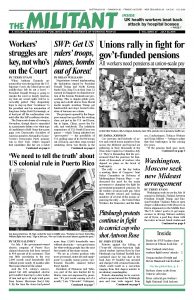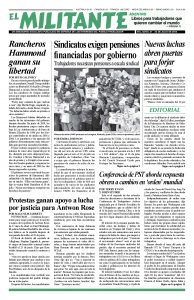Washington seeks to use the July 16 summit in Helsinki, Finland, between President Donald Trump and Russian President Vladimir Putin to open deeper collaboration with Moscow on future alignments in the Middle East. The U.S. rulers’ goal is to get acquiescence to driving Tehran’s military out of Syria, a goal they share with the rulers in Israel, Saudi Arabia and other Sunni-led regimes in the area.
The U.S. president will also take part in the NATO summit in Brussels, where he is pressing the capitalist rulers in Europe to stop freeloading on Washington’s back and kick in a higher share of the military alliance’s budget.
The Washington/Moscow summit takes place on the heels of airstrikes July 8 by the Israeli rulers in Homs, Syria, targeting Tehran’s military and allied forces there. This was the third time in a year Tel Aviv has bombed the Homs base with no complaints from Moscow. Since 2015 the Russian rulers have increased their sway in the Mideast, using air power against Syrian opposition forces to restore Bashar al-Assad’s tyranny over much of the country.
While the Russian rulers sit atop a significantly weaker military and economic power, Moscow’s role in the region is reflected in those coming to meet with Putin this week. In addition to Trump, he will sit down with Israeli Prime Minister Benjamin Netanyahu; Ali Akbar Velayati, senior adviser to Iranian leader Ayatollah Ali Khamenei; and Palestinian Authority President Mahmoud Abbas. The Iranian rulers have deployed ground forces alongside allied Hezbollah militias across Syria. They aim to entrench themselves there, extending their counterrevolutionary influence across the region while also strengthening their position against Tel Aviv. Iran’s cleric-led capitalist government — which calls for Israel’s destruction and for driving the Jews into the sea — now faces growing pressure to pull back due to Washington’s decision to renew sanctions and to Israeli airstrikes.
A new onslaught by Moscow and the Assad regime against opposition-held areas in southwestern Syria has driven an estimated 189,000 people to flee towards the Israeli border. In response, the Israeli rulers have reinforced their military positions in the Golan Heights. They are wary that as the Syrian army advances it could bring Tehran-backed forces allied with Assad closer to the Israeli border.
Washington still maintains formidable military forces in the Mideast, but has not deployed them in the kind of bloody wars waged by previous administrations. But it wants Moscow’s consent as it moves against Tehran. The capitalist rulers in Russia are seeking to defend their strategic interests, particularly their military base and warm-water naval port in Syria.
NATO’s inter-imperialist tensions
None of Washington’s NATO allies are centrally involved in the steps the U.S. rulers are taking in the Mideast. The declining powers in Germany, France and the United Kingdom have concentrated on defending their interests through the protectionist European Union trading bloc, seeking to compete with U.S. capitalists and those from other countries with tariffs. They do so while relying on the U.S. rulers’ military umbrella through NATO, while contributing relatively few funds or weaponry to maintain it.
They don’t attempt to deploy the kind of armed might capitalist classes have historically needed to defend their interests and to deter competitors from any threat of turning trade wars into shooting wars.
The German navy had to withdraw its only two tankers, both built in 1974, from NATO operations earlier this year for repairs. The British navy — declining steeply from one of the world’s largest decades ago — increasingly relies on “cannibalized” parts removed from other equipment to operate.
Washington established NATO in 1949 in Europe as part of exercising its domination over the world capitalist order, building on the victory over its rivals in the second imperialist world war. It has since grown to encompass the conflicting ruling classes of 29 countries across Europe. With the EU increasingly coming apart, as the international crisis and competition of capital pushes each member nation’s rulers to look out more and more for themselves, NATO means less and less. No one believes today that NATO’s Article 5 commitment to mutual self-defense is still binding. Just ask NATO “partners” Georgia and Ukraine when they were invaded by Moscow without any NATO response.
On his way to Brussels, President Trump stepped up his attacks on his European “allies.” He excoriated the EU’s $151 billion trade surplus against U.S. capitalists, saying he “cannot guarantee” it won’t affect relations with NATO.
He singled out the German rulers, the main beneficiary of the EU setup. He said Angela Merkel’s government was “a captive of Russia” for allowing the Moscow-owned Nord Stream 2 natural gas pipeline to run directly to Germany, bypassing eastern Europe. “How can you be together when a country is getting its energy from the country you want protection against?” he told Berlin’s European allies. “They’re just making Russia richer.”
At the same time as the U.S. rulers’ summit negotiations with Moscow near, administration officials say Washington continues to oppose Moscow’s 2014 annexation of Crimea and will maintain sanctions on Russia. But when asked if Washington’s position on sanctions could soften, both Trump and National Security Adviser John Bolton said, “We’ll see.”

